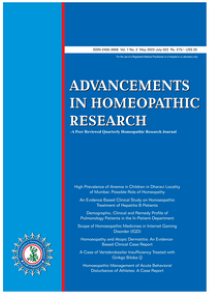A Study to Ascertain the utility of Homoeopathic Remedy Kali Phos in Diabetic Polyneuropathy
Keywords:
diagnosed, Diabetic, neuropathies, MellitusAbstract
Diabetes refers to a group of common metabolic disorders that share the phenotype of hyperglycemia. Several distinct types of Diabetes mellitus are caused by a complex interaction of genetics and environmental factors. Diabetes is the leading cause of end-stage renal disease and it also predisposes to cardiovascular diseases.
Diabetes mellitus and its complications produce a wide range of symptoms and signs. Those secondary to acute hyperglycemia may occur at any stage of the disease, whereas those related to chronic complications begin to appear during the second decade of Hyperglycemia. Individuals with previously undetected type 2 Diabetes Mellitus may present with chronic complications of Diabetes Mellitus at the time of diagnosis.
Diabetes Mellitus is classified on the basis of the pathogenic process that leads to hyperglycemia, as opposed to earlier criteria such as age of onset or type of therapy. Type 1 Diabetes Mellitus is result of complete or near total insulin deficiency. Type 2 Diabetes Mellitus is a heterogeneous group of disorders characterized by variable degrees of insulin resistance, impaired insulin secretion and increased glucose production. Type 2 Diabetes Mellitus is preceded by a period of abnormal glucose
homeostasis classified as impaired fasting glucose or impaired glucose tolerance.
Two features of the current classification of Diabetes Mellitus diverge from previous classifications. First, the terms insulin-dependent diabetes mellitus (IDDM) and non insulin dependent diabetes mellitus (NIDDM) are absolete. Since many individuals with type 2 Diabetes Mellitus eventually require insulin treatment for control of glycemia, the use of the term NIDDM generated considerable confusion.
A second difference is that age is not a criterion in the classification system. Although type 1 Diabetes Mellitus most commonly develops before the age of 30, an autoimmune beta cell destructive process can develop at any age. It is estimated that between 5 and 10% of individuals who develop Diabetes Mellitus after age 30 years have type 1 Diabetes Mellitus. Although type 2 Diabetes Mellitus more typically develops with increasing age, it is now being diagnosed more frequently in children and young adults, particularly in obese adolescents.
Diabetic neuropathies are nerve damaging disorders associated with diabetes mellitus. These conditions are thought to result from diabetic microvascular injury involving small blood vessels that supply nerves (vasa nervorum) in addition to macrovascular conditions that can culminate in diabetic neuropathy.




